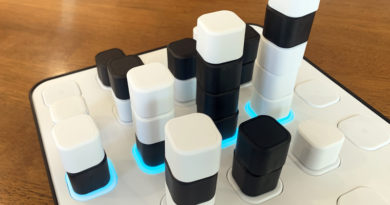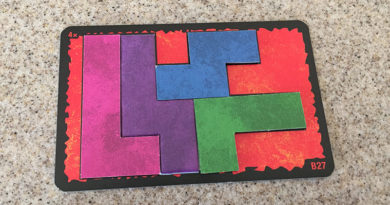Fun head-to-head tree growing in Kodama Duo
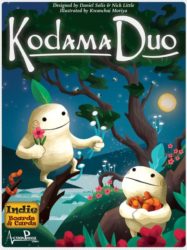
It’s a new year in the forest of Kodama and time for a friendly competition to see who can grow the best tree for the tree spirits.
Will you be the caretaker who grows your sapling into the most attractive tree (and scores the most points)?
Maybe it’s time you found out.
As you might have guessed by the name, Kodama Duo is a 2-player game. It’s published by Indie Boards and Cards and is a derivative version of a game published a few years ago – Kodama: The Tree Spirits.
But whether you’ve played the original or not, Kodama Duo completely stands on its own. In fact, we’ve never played Kodama: The Tree Spirits and it doesn’t matter one bit in understanding Kodama Duo or enjoying the game.
How to play Kodama Duo
Kodama Duo is played over 12 rounds in which players add branch card segments to their tree to attract different tree spirits and score points. At the end of each season (every 4 rounds), players will also score bonus points based on their choices. The player with the most points at the end of the game wins.
The central mechanism of the game is an “I-split-you-choose” method for players to gain branch cards to add to their tree.
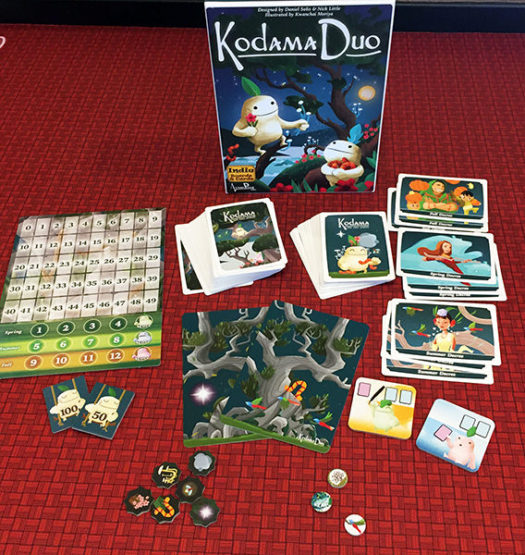
To begin, each player takes a tree trunk card for their base. They’re also each dealt 4 Kodama cards which they’ll use at the end of the seasons.
The season Decree cards are shuffled, and one is drawn face down for each season (Spring, Summer, Fall). The Spring Decree card is then flipped face up and the game is ready to begin.
Each season’s Decree card provides special rules for the subsequent 4 rounds of that season.
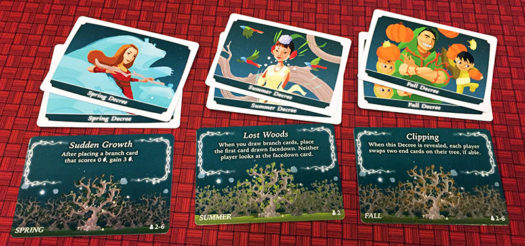
Each round one player is designated as the Splitter and the other player is the Chooser. These roles alternate each round during a season.
The Splitter draws 3 branch cards and sets them out face up in the middle of the table. They then divide the cards into two groupings as they desire. One group will only have 1 card and the other pile with have 2 cards.
The Chooser then selects which group of cards they want. The Splitter then takes the remaining group of cards.
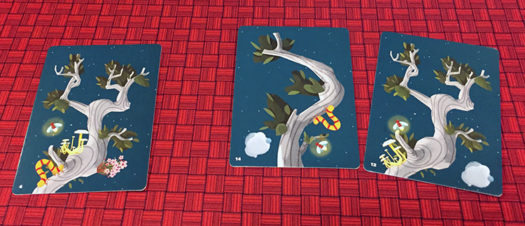
Each player then adds 1 brand card to their tree.
The entry branch of the newly placed branch card must touch bark on an existing card. It may only touch one other card and cannot cover a feature on that card. Players also can’t place a card if it would score more than 10 points.
Which brings us to how players score points.
After placing a new branch card, each player looks at the tree spirits featured on that new card. Players score 1 point for each instance of that spirit in that contiguous line of cards. Players don’t score points for other instances of that spirit if they’re not part of the contiguous line of cards containing that spirit.
Thus, in order to score a spirit, there must also be that same spirit on the card the new card was connected to (otherwise it’s not contiguous).
Players move their score marker ahead on the score track equal to their gained points.
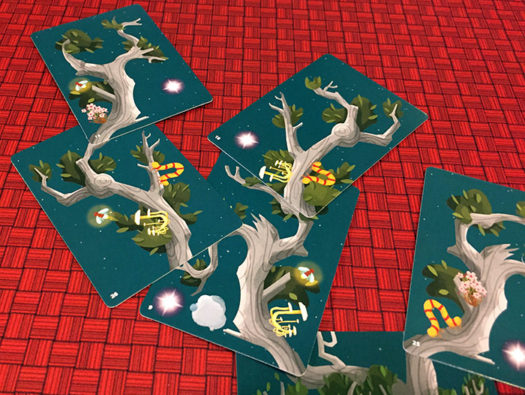
The player who took the group of 2 cards then discards the card not added to their tree and collects a spirit token matching a spirit feature on the discard card. The token can be collected from the central pile, their opponent’s tree, or even from a different location on their own tree.
They add this spirit token to any card on their tree by covering up a printed tree spirit on that card.
If the round marker was on the final space of a season line, it’s now time for the Kodama phase.
At this point, each player chooses one of the Kodama cards from their hand to score. They discard that card from the game and move their score marker that many points on the score track.
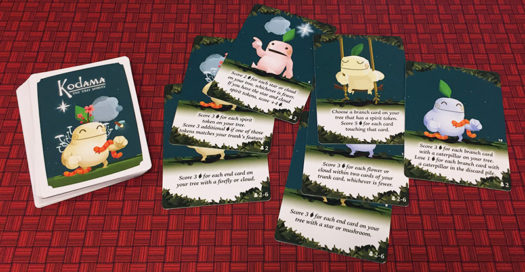
Then the round marker is advanced one space along the season track.
If it moves to a new season row, the next season Decree card is revealed and that special rule will be followed over the next 4 rounds.
Play continues like this until the end of the 12th round.
The player with the most points after the Fall season wins!
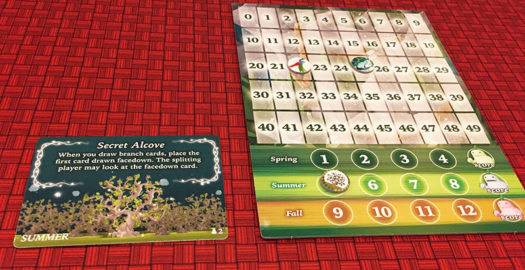
Can the whole family enjoy Kodama Duo?
The unique theme and simple play of Kodama Duo make it fun game most of the family can enjoy playing. The published, recommended age on the box is 14+ but we’d suggest it be closer to 10+.
That’s because the game is very easy to understand how to play, yet it still requires strategic choices to do well.
Sure young players can enjoy adding branches to their tree and seeing what it grows in to. But every round there are choices in how to split the 3 cards, which grouping to choose, and where to add it to your tree. These may seem straightforward, but there’s a lot more going on than you realize at first blush.
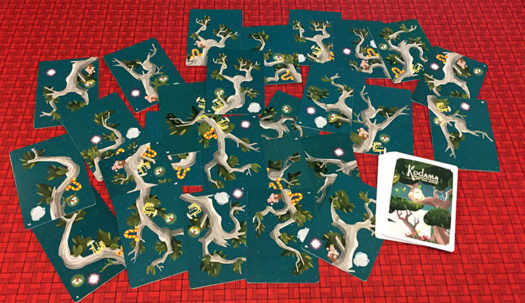
As each player can clearly see the other player’s tree, they can also see which tree spirits the other player is trying to add to their tree to score the most points. This makes choosing how to split the cards very important.
And whoever takes the grouping of 2 cards will get to discard one for a tree spirit token to add to their tree as well. So trying to limit their options on which tree spirit token they may get is another important choice to consider.
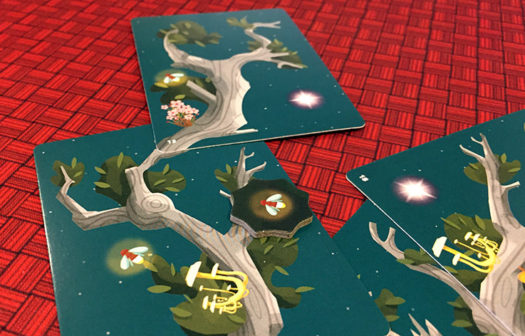
Most of all however are the secretly held Kodama cards that grant bonus points at the end of each season. These won’t be known by the other players. Yet, which cards you choose to play at the end of each season, can make a big difference in your final score.
It’s good to think ahead as to which of the Kodama cards you plan to play after each of the three seasons so you can make your branch card choices (of which to take and where to place) no only about short-term point gains upon placing, but also that will score the most bonus points when you play your Kodama cards.
Players must also consider the way the Decree cards will change the rules up in each season. That’s another layer to take into consideration with each round and potential scoring.
We’ve really enjoyed playing Kodama Duo. It’s a cool 2-player game that feels a bit zen-like even though you’re in a head-to-head battle.
Because win or lose, it’s still fun to see what your tree has grown into by the end of the game.
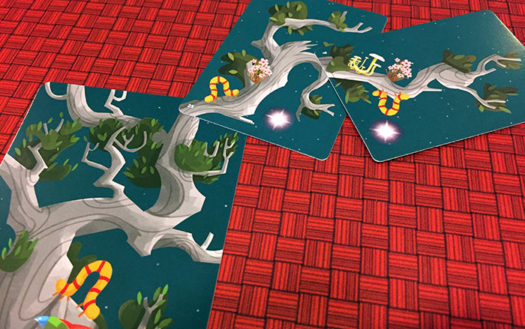
How does Kodama Duo score on our “Let’s Play Again” game meter?
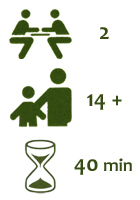 Kodama Duo scores high on our “let’s play again” game meter for a few reasons.
Kodama Duo scores high on our “let’s play again” game meter for a few reasons.
First, because it’s a straightforward game to play without extensive rules. Because of that, it’s also a game my wife enjoys. And as our kids keep get older and leave home, 2-player games she enjoys playing with me are becoming even more important in my book.
It’s also very simple to reset and play back-to-back games. Since there are only 12 rounds in the game, the game goes by quickly. Just reshuffle all the cards and you’re back in action.
Because of its compact size, Kodama Duo is also an easy game to take along on trips. We don’t imagine it playing on an airplane while you travel (because there’s no way your tree will be contained on a small airplane seat tray), but it can be fun to play once you get where you’re going.
If you’re looking for a nice 2-player game with a mix of luck and strategic choices, Kodama Duo may be just what you’re looking for.
We’d like to thank Stronghold Games and Indie Boards and Cards for a review copy of Kodama Duo.



